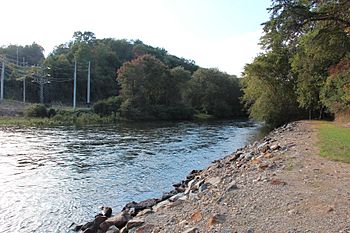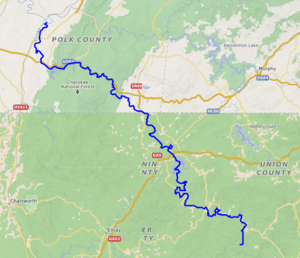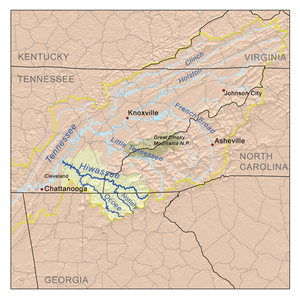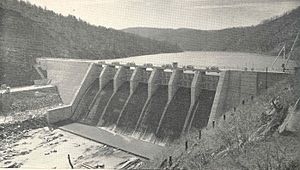Toccoa/Ocoee River facts for kids
Quick facts for kids Toccoa/Ocoee River |
|
|---|---|

Toccoa River near the Blue Ridge Dam
|
|
 |
|
| Physical characteristics | |
| Main source | Confluence of Canada and Mauldin Creeks in Union County, Georgia ~ 2,120 ft (650 m) |
| River mouth | Hiwassee River in Polk County, Tennessee ~ 750 ft (230 m) |
The Toccoa River and Ocoee River are two names for the same river! This river is about 93 miles (150 km) long. It flows northwest through the southern Appalachian Mountains in the southeastern United States. It's a smaller river that eventually joins the larger Hiwassee River in Polk County, Tennessee. Three special dams help control the river's flow and make electricity.
The river is called the Toccoa for its first 56 miles (90 km) as it flows through Georgia. When it reaches the towns of McCaysville, Georgia and Copperhill, Tennessee, its name changes to the Ocoee River. This happens right where a bridge connects Georgia 5 with Tennessee 68 and Georgia 60. The rest of the river, as it flows through Tennessee, is called the Ocoee.
The Ocoee River is famous around the world for its exciting whitewater rapids. These rapids are rated Class III-V, which means they are perfect for kayakers and rafting fans. The upper part of the Ocoee River was even used for the whitewater slalom events during the 1996 Summer Olympics. Those games were mainly held in Atlanta, about 100 miles (160 km) south.
The name Ocoee comes from the Cherokee word for a flower called Passiflora incarnata. The name Toccoa also comes from the Cherokee language. It means "where the Catawbas lived" or "beautiful."
In 1990, the river flooded parts of Copperhill, Tennessee and McCaysville, Georgia. This area was once heavily mined for copper. Mining and smelting operations caused a lot of pollution. Forests were cut down, and smog damaged plants. This led to polluted soil and water. Luckily, the area has been cleaned up and is now green again. An Olympic kayaker named Joe Jacobi helped bring the 1996 Olympic whitewater event to the Ocoee River.
Contents
How Dams Control the Ocoee River
The flow of the Ocoee River is controlled by the Tennessee Valley Authority (TVA). The TVA uses three dams to manage the water. For much of the 10-mile (16 km) section used for sports, the riverbed is almost dry. This is because the water is sent through special channels called flumes along the side of the river gorge.
Building the Ocoee Dams
The first dam was built in 1913 by the East Tennessee Power Company. Its purpose was to create hydroelectric power for the new Alcoa company. Alcoa was starting to make aluminum in Blount County, Tennessee, near Knoxville.
The three Ocoee dams are numbered from downstream to upstream. Ocoee #1 is the farthest downstream, and Ocoee #3 is the farthest upstream. The TVA took over the first two dams (Ocoee #1 and Ocoee #2) in 1939. They started building Ocoee #3 in 1940. Together, these dams produce about 67,000 kilowatts of electricity.
Water Diversion and Recreation
The Ocoee #2 dam sends water away from the middle part of the river through its flume. In 1976, a rock slide damaged this flume. While it was being fixed, the river ran freely without diversion. This was exciting for paddlers and rafting companies. They started offering rafting trips to the public.
When the flume was repaired, people wanted to keep the river open for recreation. The Ocoee River Council was formed to ask the TVA for regular water releases. After a big legal effort, including an act of Congress, the TVA agreed to release water for recreation. Now, the river is open for whitewater sports most weekends from March to October.
Exciting Rapids on the Middle Ocoee
The Middle Section of the Ocoee River has about 20 named Class III and IV rapids. These offer great opportunities for fun throughout the eight-month season. Two of the biggest rapids are "Hell's Hole" and "Powerhouse." "Hell's Hole" is right under the bridge leading to the power station. "Powerhouse" is a strong ledge with a powerful water feature right after it. Upstream from these, the TVA also operates the Blue Ridge Dam, which creates Lake Blue Ridge.
Whitewater Adventures: Kayaking and Rafting
The canoe slalom events for the 1996 Summer Olympics took place on a special half-mile Olympic whitewater course. This course gets its water from releases from Ocoee #3. The Ocoee Whitewater Center was built by the U.S. Forest Service for the Olympics. It has a large building and a parking area along U.S. 64.
Rafting the Middle Section
A 4.5-mile whitewater rafting area further downstream gets its water from Ocoee Dam #2. The Olympic section was not open to the public until after the Olympics. However, the middle section had been open to the public since the late 1970s.
After the Olympics, many companies started offering rafting tours. These tours often include bus transportation. These companies also offer other fun activities along the river, like biking, hiking, kayaking, and places to stay. Whitewater rafting is the most popular activity. Trained river guides lead groups through many exciting rapids.
Middle Ocoee Rapids List
Here are some of the rapids you can find on the Middle Ocoee:
| Mile | Name | Difficulty |
|---|---|---|
| 0.0 | Dam No. 2 | |
| 0.0 | Entrance/Grumpy | IV |
| 0.2 | Staging Eddy | III |
| 0.3 | Gonzo Shoals | III |
| 0.7 | Broken Nose | III+ |
| 0.8 | Second Helping | III |
| 1.1 | Slice-n-Dice | III |
| 1.1 | Moonshoot | III |
| 1.2 | Double Suck | III+ |
| 1.4 | Double Trouble | III |
| 1.6 | Left Right Left | III |
| 1.9 | Flipper | III |
| 2.8 | Surprise | III |
| 3.1 | Tablesaw | IV |
| 3.2 | Diamond Splitter | III |
| 3.9 | Accelerator | III |
| 4.1 | Cat's Pajamas | III |
| 4.2 | Hell's Hole | IV |
| 4.3 | Powerhouse Ledge | IV |
| 4.6 | Outfitter Takeout | |
| 5.4 | Private Boater Takeout |
Other Names for the River
The river has been known by a few different names over time. It was once called the Ocowee River. According to the Geographic Names Information System, the Toccoa/Ocoee River has also been known as:
- Taccoy River
- Tacoy River



